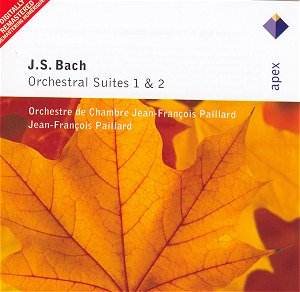This issue has pleased
me immensely despite the measly playing
time afforded this budget-priced issue.
I used to own a vinyl copy of this recording
on a World Record Club release, issued
with the other two well-known suites
and Suite No. 5 (the latter of doubtful
provenance). Paillard re-recorded these
works, but I believe these to be from
the earlier set; here at last for us
to enjoy. It was wonderful to make my
reacquaintance with these recordings.
Although the notes are quite good, there
is no information about recording dates
or location, nor are the soloists mentioned.
I believe that this was originally an
Erato release.
Any recording of these
works can be easily ruined by slow and
ponderous playing and we certainly do
not have that here. These recordings
were issued before the period performance
brigade got under way in earnest. Although
there are lively tempi and bright woodwind
parts, they are performed with modern
instruments and are recorded in a very
clear ambient acoustic. The readings
are full of life; I enjoyed them immensely.
Suite No. 1 is written
for two oboes, bassoon, strings and
basso continuo. It is, along with No.
2, one of the most reticent of the four
suites and is in seven movements, Overture,
Courant, Gavotte, Forlane, Menuet, Bourrée
and Passepied. This sequence of Overture
and a number of dances was used extensively
by a number of early composers such
as Lully, Kusser, Muffat and J.C.F.
Fischer. This suite format was known
as the ‘French Suite’ although many
such suites were composed by German
composers. This was because the concept
of the suite was developed in Paris
as a sequence of ballet pieces. Although
composed throughout Europe by many composers,
it is the Suite sequence by J.S. Bach
which has become the most popular and
most frequently performed. They are
not as formally written as the Brandenburg
concerti but nevertheless have maintained
their position in the catalogue and
have a large number of competitive versions.
The soloists here are
not mentioned by name; I suspect that
they are the principals of the Jean-François
Paillard Chamber Orchestra. They play
extremely well and the First Suite is
certainly alive and accurately pitched.
Paillard, when he re-recorded these
works later, lost some of the vivacity.
When we move on to
the Second Suite, we are on more familiar
ground. There is a fiendishly difficult
solo flute part, with strings and basso
continuo. It is a pity that Apex do
not identify the soloist as he or she
is extremely competent and can be enjoyed
for his/her work with the remainder
of the orchestra. This time, there is
again the Overture, but the dances are
different. We have Rondeau, Sarabande,
Bourrée, Polonaise and Double,
Menuet and Badinerie, the last often
played by flautists as a solo encore
when in concert. The last movement can
also be repeated in performance as an
encore; such is its popularity. Bach
plus Paillard really stretch the soloist
to the extreme, and the current artist
does not fail in the least.
Apex are to be congratulated
on this release which I can recommend
wholeheartedly, unless you are from
the brigade who insist on the full 80
odd minutes of playing time. I sincerely
hope that they have the second disc
in the pipeline with suites 3, 4, and
5. I for one will certainly be purchasing
it if and when it is released.
John Phillips


